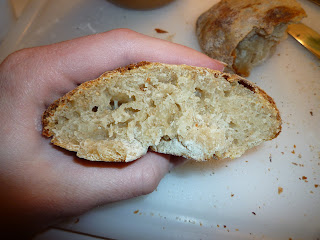My first real knowledge deficit is about types of flour. I usually use whatever unbleached flour or bread flour is in my pantry rather than carefully following the different types of flour advised in recipes. I also often substituted whole wheat for rye flour (as I am not a huge fan of rye). Doing some reading, I realized that this could be a problem. According to Cookwise
Another problem I am having is temperature verses time. Many recipes call for the bread to rise at specific temperatures or assume about 75 degrees F. The problem is that with a fairly open kitchen, it would be ridiculous to heat the entire house to 75 degrees F. So I increase rising times. However, all of these increases are approximations. Because the house is between 68-70 degrees, how much should I increase? I tried to google search and I couldn't find much. Today, the second half of the Pain au Levain that I left in the refrigerator, was still cold after it had been sitting out for two hours. Wanting to have the bread in time for dinner, I decided to proof it at a higher temperature by turning the oven on for a short burst of heat, letting it out, and leaving it about what I thought was about 85 degrees F. The dough rose more beautifully than any of my previous sourdough creations.
 |
| Pre-proof |
 |
| Post-proof. |
 |
| Funky looking but crunchy crust. |
 |
| Dinner roll crumb. |
Speaking of sourdough, I did something rather unusual to my sourdough starter. One day when I was not paying attention, I accidentally mixed some of the sourdough starter from my Alma Mater into my sourdough from home (so I now have one hybrid whole wheat along with my "pure" starters from each place). My Alma Mater was in one of the prime sourdough cities, my home is not. What will happen to this hybrid? Will one yeast become dominant and kill off the other? Will they cohabitate and produce a mixed-flavor bread? Will they bread and create a new starter? According to Wikipedia, yeast generally reproduces by asexual reproduction, which would mean that the two yeasts would remain differentiated. However, under conditions of stress, apparently, the yeast reproduces sexually which means that I might end up with hybrid yeast. I wonder. Thoughts?
The final thing about which I wanted to wonder in print was the ratio between first and second fermentation. Corriher says that the bread rises faster during the proofing than it does during its first fermentation (Corriher 4). Does this mean that the second proofing should be shorter? Should I have made my sourdough first fermentation six hours instead of the second one when I made Pain au Levain? I am still not sure. Which one of the two fermentation increases the flavor more? Cookwise provided no answer. Does anyone know?
No comments:
Post a Comment